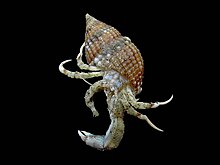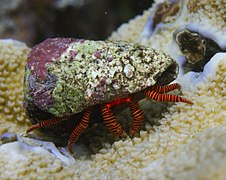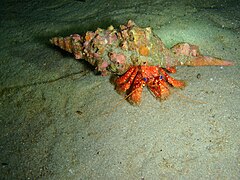
Hermit crabs are anomuran decapod crustaceans of the superfamily Paguroidea that have adapted to occupy empty scavenged mollusc shells to protect their fragile exoskeletons. There are over 800 species of hermit crab, most of which possess an asymmetric abdomen concealed by a snug-fitting shell. Hermit crabs' soft (non-calcified) abdominal exoskeleton means they must occupy shelter produced by other organisms or risk being defenseless.

The Coenobitidae are the family of terrestrial hermit crabs, widely known for their land-living habits as adults. They are found in coastal tropical regions around the world and require access to the ocean to breed.

Clibanarius is a genus of hermit crabs in the family Diogenidae. Like other hermit crabs, their abdomen is soft-shelled and sheltered in a gastropod shell. Typically marine like all their relatives, the genus includes C. fonticola, the only known hermit crab species that spends all its life in freshwater. The feeding rates of Clibanarius species change with temperature which, given their broad distributions, may have considerable consequences for the stability reef systems as sea temperatures rise in the future.

Coenobita cavipes is a species of land hermit crab native to the eastern parts of Africa, the Indonesia, Philippines, China, Japan, Malaysia, Taiwan, Polynesia, and Micronesia. While these hermit crabs are terrestrial, they prefer to reside near the shores for access of both water and land.
Echidnocerus is a genus of king crab. It includes Echidnocerus foraminatus and Echidnocerus cibarius, the Puget Sound king crab. The genus was long known as Lopholithodes until it was discovered in 2022 that Lopholithodes is a junior synonym of Echidnocerus.
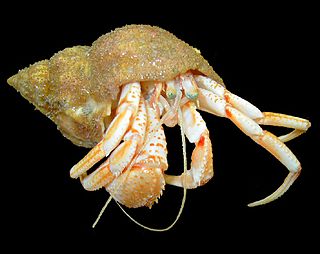
The Paguridae are a family of hermit crabs of the order Decapoda. The king crabs, Lithodoidea, are now widely understood to be derived from deep within the Paguridae, with some authors placing their ancestors within the genus Pagurus.
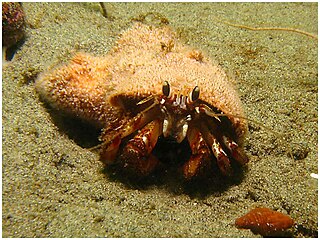
Pagurus is a genus of hermit crabs in the family Paguridae. Like other hermit crabs, their abdomen is not calcified and they use snail shells as protection. These marine decapod crustaceans are omnivorous, but mostly prey on small animals and scavenge carrion. Trigonocheirus and Pagurixus used to be considered subgenera of Pagurus, but the former is nowadays included in Orthopagurus, while the latter has been separated as a distinct genus.
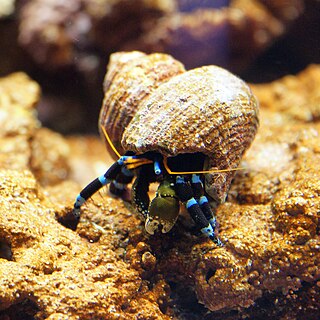
Calcinus is a genus of hermit crabs in the family Diogenidae, containing the following species:

Paguristes is a genus of hermit crab in the family Diogenidae. It includes the following species :

Hapalogastridae is a family of decapod crustaceans, belonging to king crabs in the broadest sense, containing the following species:
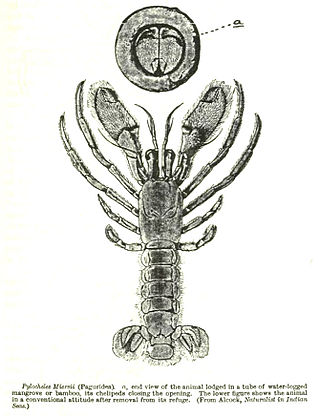
The Pylochelidae are a family of hermit crabs. Its members are commonly called the 'symmetrical hermit crabs'. They live in all the world's oceans, except the Arctic and the Antarctic, at depths of 2,000 m (6,600 ft). Due to their cryptic nature and relative scarcity, only around 60 specimens had been collected before 1987, when a monograph was published detailing a further 400.

Diogenes is a genus of hermit crabs.

Dardanus megistos, the white-spotted hermit crab or spotted hermit crab, is a species of hermit crab belonging to the family Diogenidae.
Ciliopagurus liui is a species of hermit crab native to the Gulf of Tonkin and waters to the south of Japan.
The Pylojacquesidae are a small family of hermit crabs, comprising only two species in two genera. The family was erected in 2001, after two specimens at Museum für Naturkunde at the Humboldt-Universität zu Berlin were recognised as being quite distinct from other described hermit crabs. The family members differ from other hermit crabs in that their mandibles are chitinous and toothed.

The thinstripe hermit crab, Clibanarius vittatus, is a species of hermit crab in the family Diogenidae. It is found in the Caribbean Sea, the Gulf of Mexico and the western Atlantic Ocean.

Dardanus lagopodes, known commonly as the hairy red hermit crab, is a species of marine decapod crustacean in the family Diogenidae. Dardanus lagopodes is widespread throughout the tropical waters of the Indo-West Pacific region, including the Red Sea. It reaches a length of 10 centimetres (3.9 in).

Dardanus tinctor, the anemone hermit crab, is a species of marine hermit crab in the family Diogenidae. Dardanus tinctor is widespread throughout the tropical waters of the Indo-West Pacific region, including the Red Sea. It reaches a length of 10 centimetres (3.9 in).
Coenobita rubescens is a species of terrestrial (land-living) hermit crab, family Coenobitidae.

Calcinidae is a family of aquatic hermit crab of the superfamily Paguroidea.
